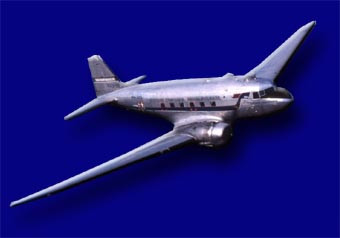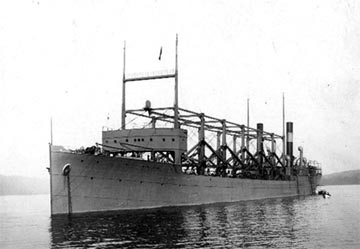 A five-masted schooner built in 1919, the Carroll A. Deering was found hard aground and abandoned at Diamond Shoals, near Cape Hatteras, North Carolina on January 31, 1921. Rumors and more at the time indicated the Deering was a victim of piracy, possibly connected with the illegal rum-running trade during Prohibition, and possibly involving another ship, S.S. Hewitt, which disappeared at roughly the same time. Just hours later, an unknown steamer sailed near the lightship along the track of the Deering, and ignored all signals from the lightship. It is speculated that the Hewitt may have been this mystery ship, and possibly involved in the Deering crew's disappearance.
A five-masted schooner built in 1919, the Carroll A. Deering was found hard aground and abandoned at Diamond Shoals, near Cape Hatteras, North Carolina on January 31, 1921. Rumors and more at the time indicated the Deering was a victim of piracy, possibly connected with the illegal rum-running trade during Prohibition, and possibly involving another ship, S.S. Hewitt, which disappeared at roughly the same time. Just hours later, an unknown steamer sailed near the lightship along the track of the Deering, and ignored all signals from the lightship. It is speculated that the Hewitt may have been this mystery ship, and possibly involved in the Deering crew's disappearance.
Bermuda Triangle Documentary
Visit documentary-log.com to watch documentaries online!
Tuesday, August 25, 2009
Carroll A. Deering
 A five-masted schooner built in 1919, the Carroll A. Deering was found hard aground and abandoned at Diamond Shoals, near Cape Hatteras, North Carolina on January 31, 1921. Rumors and more at the time indicated the Deering was a victim of piracy, possibly connected with the illegal rum-running trade during Prohibition, and possibly involving another ship, S.S. Hewitt, which disappeared at roughly the same time. Just hours later, an unknown steamer sailed near the lightship along the track of the Deering, and ignored all signals from the lightship. It is speculated that the Hewitt may have been this mystery ship, and possibly involved in the Deering crew's disappearance.
A five-masted schooner built in 1919, the Carroll A. Deering was found hard aground and abandoned at Diamond Shoals, near Cape Hatteras, North Carolina on January 31, 1921. Rumors and more at the time indicated the Deering was a victim of piracy, possibly connected with the illegal rum-running trade during Prohibition, and possibly involving another ship, S.S. Hewitt, which disappeared at roughly the same time. Just hours later, an unknown steamer sailed near the lightship along the track of the Deering, and ignored all signals from the lightship. It is speculated that the Hewitt may have been this mystery ship, and possibly involved in the Deering crew's disappearance.
Spray
S.V. Spray was a derelict fishing boat refitted as an ocean cruiser by Joshua Slocum and used by him to complete the first ever single-handed circumnavigation of the world, between 1895 and 1898.
In 1909, Slocum set sail from Vineyard Haven bound for Venezuela. Neither he nor Spray were ever seen again.
There is no evidence they were in the Bermuda Triangle when they disappeared, nor is there any evidence of paranormal activity. The boat was considered in poor condition and a hard boat to handle that Slocum's skill usually overcame.
The Fate of Flight 19

Flight 19 was a training flight of TBM Avenger bombers that went missing on December 5, 1945 while over the Atlantic. The squadron's flight path was scheduled to take them due east for 120 miles, north for 73 miles, and then back over a final 120-mile leg that would return them to the naval base, but they never returned. The impression is given that the flight encountered unusual phenomena and anomalous compass readings, and that the flight took place on a calm day under the supervision of an experienced pilot, Lt. Charles Carroll Taylor. Adding to the intrigue is that the Navy's report of the accident was ascribed to "causes or reasons unknown." It is believed that Taylor's mother wanted to save her son's reputation, so she made them write "reasons unknown" when actually Taylor was 50 km NW from where he thought he was.
Adding to the mystery, a search and rescue Mariner aircraft with a 13-man crew was dispatched to aid the missing squadron, but the Mariner itself was never heard from again. Later, there was a report from a tanker cruising off the coast of Florida of a visible explosion at about the time the Mariner would have been on patrol.
While the basic facts of this version of the story are essentially accurate, some important details are missing. The weather was becoming stormy by the end of the incident, and naval reports and written recordings of the conversations between Taylor and the other pilots of Flight 19 do not indicate magnetic problems.
The Disappearance of NC16002
 NC16002 was a DC-3 passenger plane that vanished on the night of December 28, 1948, during a flight from San Juan, Puerto Rico, to Miami, Florida. The weather was fine with high visibility and the flight was, according to the pilot, within 50 miles of Miami when it disappeared with its three crew members and twenty-nine passengers. Though no probable cause for the loss was determined by the official investigation, it is known that the plane's batteries were not fully charged on takeoff and this may have interfered with communications during the flight. A message from Miami to the plane that the direction of the wind had changed may have not been received by the pilot, causing him to fly up to fifty miles off course.
NC16002 was a DC-3 passenger plane that vanished on the night of December 28, 1948, during a flight from San Juan, Puerto Rico, to Miami, Florida. The weather was fine with high visibility and the flight was, according to the pilot, within 50 miles of Miami when it disappeared with its three crew members and twenty-nine passengers. Though no probable cause for the loss was determined by the official investigation, it is known that the plane's batteries were not fully charged on takeoff and this may have interfered with communications during the flight. A message from Miami to the plane that the direction of the wind had changed may have not been received by the pilot, causing him to fly up to fifty miles off course.
SS Marine Sulphur Queen Vanishes
The USS Cyclops Sinking
One of the first stories connected to the Triangle legend and the most famous ship lost in the region was the USS Cyclops which disappeared in 1918. The 542 foot long Cyclops was launched in 1910 and served as a collier ( a ship that carries coal) for the U.S. Navy during World War I. The vessel was on its way from Bahia, Salvador, to Baltimore, Maryland, but never arrived. After it had made an unscheduled stop at Barbados on March 3rd and 4th to take on additional supplies, it disappeared without a trace. No wreckage from the ship was ever found and no distress signal was received. The deaths of the 306 crew and passengers of the USS Cyclops remains the single largest loss of life in U.S. Naval history not directly involving combat.
The USS Cyclops in a 1911 photograph. (USN Photo) |
While the sinking of the Cyclopsremains a mystery, the incident could have happened anywhere between Barbados and Baltimore, not necessarily in the Bermuda Triangle. Proponents of the Bermuda Triangle theory point to the lack of a distress call as evidence of a paranormal end for the vessel, but the truth is that wireless communications in 1918 were unreliable and it would not have been unusual for a rapidly-sinking vessel to not have had a chance to send a successful distress call before going under.



